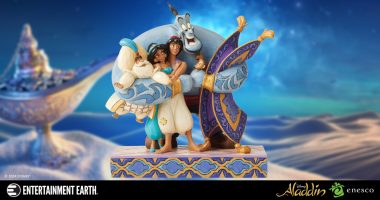For almost the last century, Western culture has been profoundly shaped, for better or worse, by Walt Disney Studios. The very name “Disney” has powerful associations for people: with childhood nostalgia, with dated ideals, with dreams and magic, with passivity over hard work, with escapism, with cultism. Reactions fall all over the map, and whether positive or negative, they are usually strong. No critical reading of a text can be without bias, and that’s especially true when approaching something as culturally charged as a Disney film.
But Anastasia and I are Disney fans who like a challenge. Over the coming months, we will be making our way through each film produced by the Walt Disney Animation Studios that is considered part of the studio’s animated canon. Some of these movies we could recite backwards in our sleep, others we only have vague half-memories of from childhood television specials. The aim is to try and approach these movies with a fresh eye, to discuss their history and production, and consider their strengths as films. Objectivity is not a concern – critical objectivity is a myth – so much as testing our own existing opinions about the films and the studio that made them.
Snow White and the Seven Dwarfs is not the beginning of the Disney animation story, but it’s where we’re going to start. It was the 1930s, and America was in the stranglehold of the Great Depression. Yet despite economic hardship, audiences were attending the cinema in droves, searching for an escape from a grim reality. At the time, live-action films were preceded by animated short films produced by studios like Warner Bros., Fleischer, MGM, UPA, and Disney. Characters like Betty Boop, Porky Pig, Felix the Cat, and Popeye the Sailor were gracing silver screens alongside actors like Clarke Gable, Jean Harlow, Fred Astaire and Ginger Rogers, and Katherine Hepburn.
Unlike other studios, Walt Disney realized quickly that in the long term, animated shorts wouldn’t be financially sustainable. Part of this was because unlike a lot of the studios, Disney didn’t have feature length live-action films to bundle with their animated shorts. But Walt was a person who demanded the perfection, experimentation, and advancement of animation. Such demands rendered shorts more costly to produce, and despite higher rental fees on Disney cartoons, shorts still had to make about $100,000 to start turning a profit. Walt decided the way to diversify the business was to make full-length animated features.
To say people at the studio balked at the idea would be an understatement. From the beginning there were concerns that an audience simply wouldn’t be able to sit for 90 minutes and watch a cartoon. It seems ludicrous nowadays, but until then, animation was firmly tied to short subjects that were heavy on gags and light on story. Colors were bright and bold, which works great for a six minute short, but might fatigue audiences staring at them for extended periods. Walt himself worried throughout the production of the film that the audience would be unable to connect with animated characters in the same way they connected to live-action actors. The desire was to push the medium beyond what they had been able to achieve in the short films, and delve into the psychology of the characters to help carry the story and animation.
There was also the sheer man-power needed to complete the film. The company kick-started a massive recruitment drive in the early 30s, intending to pull in young artists they could begin training to work on a full-length feature. Many of the most famous Disney animators of the era – including all of the Nine Old Men with the exception of Les Clarke – were hired during this period. Walt sent representatives directly to Chouinard Art Institute to recruit new graduates. The men hired often had key points in common: they were from immigrant families, had experienced isolating or fractured childhoods, and found escape in their art. Despite the studios best efforts, they still had to push for even more recruitment in 1937 to have a hope of meeting the promised Christmas release.
Walt’s search for perfection caused headaches and delays throughout the production. He would spend hours and hours in meetings going over the same scenes, the same characters, with the same people, trying to pull things together. Though it was a collective effort on the part of the 600 strong staff, there was no question to those working on Snow White that what they were trying to do was recreate Walt’s vision on screen. He had it clearly in his mind; he could act out a three-hour long version of the story at the drop of a hat to anyone who would listen. He lived and breathed Snow White. Every treatment of the script was picked over word by word, and every animated gesture was analyzed and fretted over. He went to such lengths that he then began to worry all this revising and refining and tweaking would drain the film of the spontaneity it would need to feel life-like to the audience.
The budget also went out the window very quickly. The initial estimated cost of the film was $250,000, but even before they started that rose to $400,000. As the production dragged out, so did the budget, and additional loans from the Bank of America, each over $600,000, were taken out in 1936 and 1937. To compare, Disney’s short films at the time cost around $30,000 to produce, and this was considered expensive for an animated short. Walt was spending $20,000 a week on Snow White. His brother and business partner Roy was the financial man at the studio, and Walt’s spending was cranking up tensions between them. Roy did everything he could to force Walt to cut costs, but this chaffed Walt, who complained “I can’t be strapped down by a limited budget”. All told, Snow White cost $1.4 million to make, $25 million in today’s money, and far more than the original pie-in-the-sky estimate of $250,000.
Later, Walt was fond of talking about how he was derided in Hollywood for wanting to create a full-length animated feature. But biographer Neal Gabler writes there was little foundation for this; it was likely Walt’s habit of self-dramatization on display. The film was greeted with great anticipation, and the question of whether or not the thing would be finished appears to have been concentrated within the studio. The first cels were sent to Ink and Paint in early January of 1937, and it took until March to get them to the camera for photography. 1937 was an utter mad dash to get the film ready for the December release date. Walt was forced to compromise on quality, OK’ing work he normally would have sent back. Even with concessions on quality, the final photography wasn’t completed until the 1st of December.
Fortunately for the studio, it paid off. The film was met with near universal acclaim, and any fears Walt and the animators harbored about the audience being unable to connect with animated characters were quickly allayed. Animator Ward Kimball said later, “Clark Gable and Carole Lombard were sitting close, and when Snow White was poisoned, stretched out on that slab, they started blowing their noses. I could hear it – crying – that was a big surprise.” As for the financial side, the studio made enough money on the film to move out of the old Hyperion lot and into one in Burbank, where the studio remains today. Adjusted for inflation, Snow White and the Seven Dwarfs is still one of the top 10 highest grossing films at the North American box office.
Snow White and the Seven Dwarfs was widely regarded as an instant classic, and it has been re-released dozens of times since 1937. It really is a beautiful film. The animation is a triumph of its era, particularly on Snow White and the Queen. The studio tested techniques to use for Snow White in the animated shorts, and comparing the feature film to something like The Goddess of Spring is like looking at work from two different eras. The Goddess of Spring was released in November 1934, a mere three years before the premiere of Snow White, and the animation on the titular goddess Persephone is… well, “horrifying” is a strong word. But while the rubber-armed boneless look is charming on human caricatures and anthropomorphic mice, it falls squarely into uncanny valley territory on realistic human characters. That the animators made such a jump in ability in three short years is nothing less than astonishing.
Some would put this down to the use of rotoscoping in the film, but rotoscoping was strongly discouraged by Walt, and in the end used only sparingly when the Christmas release date was looming. For the uninitiated, rotoscoping is where live-action footage is traced over to create animation. It was a technique developed by Fleischer Studios, and it was used to great effect in some of their Betty Boop shorts. Rotoscoping is a tool, and deployed well, it can make for memorable sequences. It has an uncanny bearing to it, which is exactly what you want when you’re creating a Cab Calloway ghost walrus. But later uses in Ralph Bakshi’s The Lord of the Rings are less successful, lending an oddly over-animated look to the characters. To the credit of Disney animators, the few rotoscoped scenes there are blend seamlessly with the animation around them. None of them jump out at you like rotoscoping normally does. While there are some aspects to the animation that look strange to a modern eye – clothing and feathers seem to both be animated with the same kind of weight and flow – it is entirely consistent throughout the film.
The decision to use pantomime-style acting on the characters is largely successful, and detracts from the trouble the animators seem to have had with matching the lip movements to the dialogue. The animation on the dwarfs is one of the best aspects of the film. There is a clear sense of composition and the flow of the movement through the frame, particularly as the dwarfs move as a group. Watch the scene where the dwarfs sneak through their house while Snow White is asleep, and you will see a sense of flow not only in each individual pose of the dwarfs, but also in the group as a whole.
But then, you may be too caught up in watching the movie to notice the art of it. The story itself is kept simple, and it has a clear sense of storytelling logic to it. Some of the early Disney films feel very episodic in nature, but Snow White has a clear through line and the pacing keeps things moving. As a musical it resembles an opera more than the Broadway-style musical of Disney Renaissance films, but this makes the music feel a lot more seamless and integral to the story. Adriana Caselotti’s singing leaves a lot to be desired – at points she is cringe inducing – but overall she makes a sweet, charming Snow White. The dwarfs, whose characters were agonized over during production, are a lot of fun. There’s a real sense that these characters having been living and working together for a long time and we’ve stumbled into the middle of things along with Snow White. They know each other and play off one another in a way that’s genuinely entertaining.
But while they spent a lot of time working on how to portray truly life-like characters, the actual psychology and motivations leave something to be desired. Snow White makes a couple of references to wanting her dreams to come true, but we’re left to infer what these dreams are rather than shown anything concrete. Really it seems like living a happy life deep in the forest safe from your homicidal step-mother would be a dream come true. Endearing as she is, Snow White is a product of her time when a young woman having aspirations beyond marriage was generally frowned upon. The Queen is a wonderfully cinematic character, and smart enough to take advantage of Snow White’s good manners and kindness. But again, there isn’t much the audience is given in terms of motivation for her villainy. Where a modern Disney film might spend some time laying out the motivations of the step-mother, here we’re thrown right into the Queen glowering darkly over Snow White being fairest in the land.
Still, it’s a very watchable film. Sequences don’t run over long and a lot of the gags are genuinely funny. There’s no doubt some will find it saccharine – a lot of Disney Princess imagery starts here, all of it played very straight – and a small scene where Snow White prays before bed sits uncomfortably in otherwise secular surroundings. The story is a simplified version of the Grimm tale, which will make it easier for younger viewers to follow. But fans used to Disney films that touch on the long-term effects of emotional abuse or use self-aware subversion to drive the climax will be left wanting. Having said that, if you’re interested in re-watching it or watching it for the first time, it’s worth the 80 minutes. For anyone interested in the history of animation, it’s an absolute must see.
Snow White was a huge financial hit that allowed the Disney Studios to become giants of the film world almost overnight. But with war looming in Europe, the shine was about to come off the apple very quickly. Next week, we begin talking about Disney during the Second World War and why Pinnocchio was not always the critical darling it is today.
Information about the history of the studio and quotes for this article were largely sourced from the chapter entitled “Folly” in Neal Gabler’s 2006 Walt Disney: The Biography. More about the artistic development of Snow White and the Seven Dwarfs can also be found in The Illusion of Life by Frank Thomas and Ollie Johnston.










